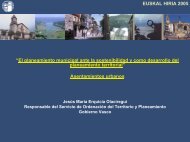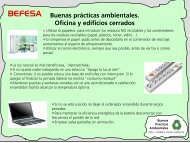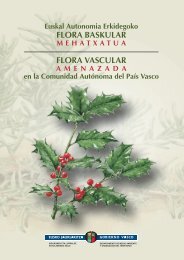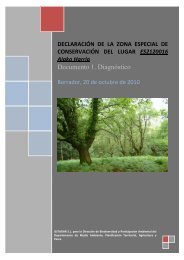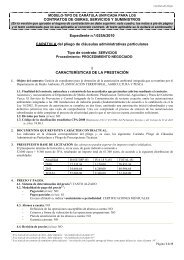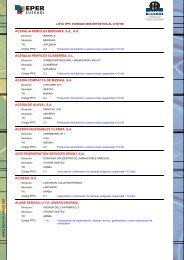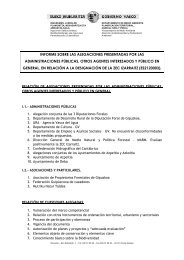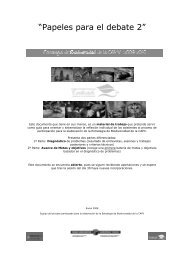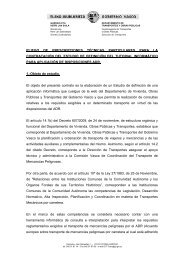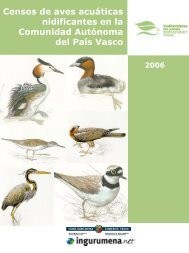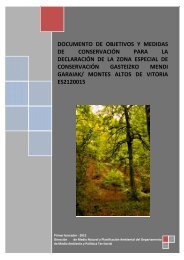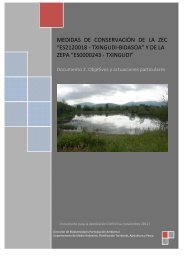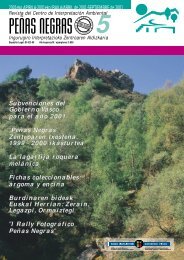Anexo III. Inventario de residuos peligrosos de la CAPV 2004
Anexo III. Inventario de residuos peligrosos de la CAPV 2004
Anexo III. Inventario de residuos peligrosos de la CAPV 2004
You also want an ePaper? Increase the reach of your titles
YUMPU automatically turns print PDFs into web optimized ePapers that Google loves.
<strong>Inventario</strong> <strong>de</strong> Residuos Peligrosos <strong>de</strong> <strong>la</strong> <strong>CAPV</strong> – Año <strong>2004</strong><br />
Tm/año Origen C.A.P.V. - Destino<br />
DIRECTO otras CC.AA.<br />
80.000<br />
70.000<br />
60.000<br />
50.000<br />
40.000<br />
30.000<br />
20.000<br />
10.000<br />
0<br />
AN AR AS CL CM CN CT GA LR MD MU NA PV<br />
04 05 06 07 08 09 10 11 12 13 14 15 16 17 18 19 20<br />
Figura 14. Exportaciones directas (sin intervención <strong>de</strong> Centros <strong>de</strong> Transferencia vascos).<strong>de</strong> <strong>residuos</strong> <strong>peligrosos</strong> en<br />
<strong>2004</strong>, <strong>de</strong>sglosados por CCAA <strong>de</strong> <strong>de</strong>stino y código LER. AN=Andalucía; AR=Aragón; AS=Asturias; CL=Castil<strong>la</strong> y León;<br />
CM=Castil<strong>la</strong> La Mancha; CN=Cantabria; CT=Cataluña; GA=Galicia; LR=La Rioja; MD=Madrid; MU= Murcia;<br />
NA=Navarra; PV=País Valenciano<br />
3.6.2 Exportaciones a otros Estados<br />
Durante <strong>2004</strong> se exportaron hacia otros Estados 8.626,30 Tm. (+21,27%) <strong>de</strong> <strong>residuos</strong> <strong>peligrosos</strong><br />
<strong>de</strong>s<strong>de</strong> empresas ubicadas en <strong>la</strong> <strong>CAPV</strong>, bien productores, bien gestores o Centros <strong>de</strong><br />
Transferencia que habían adquirido parte <strong>de</strong> dichos <strong>residuos</strong> en otras Comunida<strong>de</strong>s Autónomas:<br />
• Se afianza <strong>la</strong> inci<strong>de</strong>ncia <strong>de</strong> los Centros <strong>de</strong> Transferencia en <strong>la</strong> exportación internacional,<br />
al alcanzar el 97,44% <strong>de</strong>l total en <strong>2004</strong> (97,09% en 2003), <strong>de</strong>bido a <strong>la</strong> necesidad <strong>de</strong><br />
aplicar tratamientos <strong>de</strong> incineración a <strong>residuos</strong> halogenados, <strong>residuos</strong> sanitarios y<br />
<strong>de</strong>terminados <strong>residuos</strong> químicos o <strong>de</strong> <strong>la</strong>boratorio.<br />
• Se mantiene <strong>la</strong> cantidad exportada por empresas gestoras <strong>de</strong> <strong>residuos</strong> <strong>peligrosos</strong><br />
producidos durante sus propios procesos <strong>de</strong> tratamiento (146,29 Tm en 2003; 125,57<br />
Tm en <strong>2004</strong>).<br />
• Se mantiene como anecdótica <strong>la</strong> aportación <strong>de</strong> los productores <strong>de</strong> <strong>residuos</strong> <strong>peligrosos</strong><br />
que exportan directamente a otros Estados una parte <strong>de</strong> sus <strong>residuos</strong> (133,95 Tm en<br />
2002; 60,94 Tm en 2003; 95,58 Tm en <strong>2004</strong>).<br />
Los <strong>residuos</strong> sanitarios enviados a Francia constituyen un año más el principal flujo <strong>de</strong> exportación<br />
interestatal (2.507,29 Tm; 29,07% <strong>de</strong>l total). Sin embargo, aumenta <strong>la</strong> exportación a otros países<br />
<strong>de</strong> disolventes (+789 Tm) y <strong>de</strong> tierras contaminadas (+1.816 Tm), mientras que disminuye <strong>la</strong> <strong>de</strong><br />
pinturas (-573 Tm).<br />
Pág. 21



